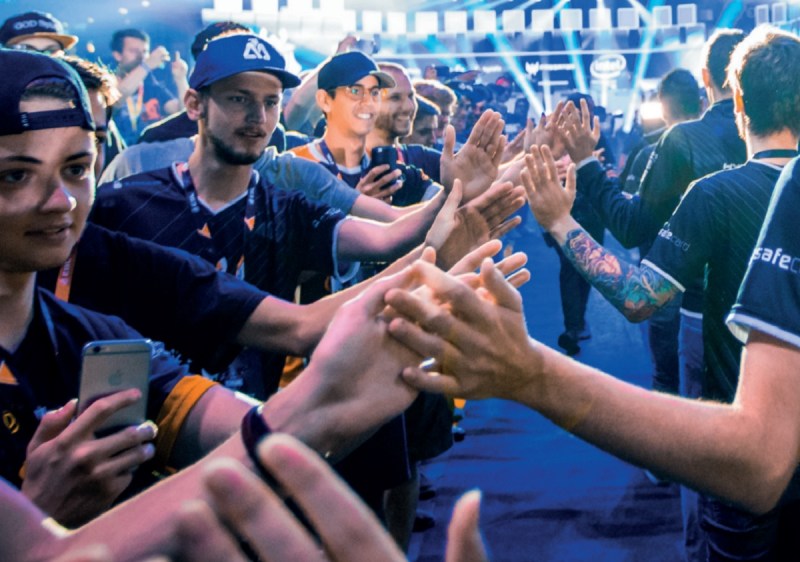
Above: Wonder
GamesBeat: Can you talk about the way the fund works, tracking your own investments? I’ve seen some of it happening before, like Peter Levin investing in Immortals and bringing in Lionsgate as an investor later. In your case, you’ve invested with your own fund, but Greycroft can come into some of these investments later?
Goldman: Right. Let me lay out the relationship. I’m a venture partner in Greycroft, the core fund. That’s the fund that does A and B rounds. I’m responsible for sitting on boards or shepherding companies. The two that I’ve championed are Fig, Justin Bailey’s company, which you know—that didn’t come through my tracker fund. That went directly to the core fund. And then a VR sports viewing company called LiveLike. Those were two investments that I championed. I sit on the boards. I’m on the board of some other companies as well, responsible for them.
Separately, there’s this tracker fund, in which Greycroft is a limited partner. They’re also my business partner. Greycroft runs the back office, which is incredibly time-consuming, more than people think. It’s a huge benefit for me in terms of meetings with companies and activating deals. All the other partners at Greycroft will help me look at and think through stuff. All the young analysts will help analyze a company. On the deal activation side I can just say, “Yep, I want to put a couple hundred thousand in this company,” and it all gets taken care of through the finance team. Every deal I do gets tracked in a database. I can look at stuff from a couple of years ago.
It’s an incredible partnership. I’m very appreciative of that partnership, because it takes all the legwork and pain out of investing. I can just focus on the companies and know that everything will be done properly. And then I’ve got the Skybound stuff, of course. I just came back from the Walking Dead cruise.
GamesBeat: As far as other things that are interesting, stuff to look forward to in 2018, what do you see?
Goldman: I’m going to be spending a lot more time in 2018 on esports and AR. I’ve invested in a young company here in Los Angeles called Camera IQ, which is kind of an authoring system for AR, easy annotation of the world. They’re best known for being the AR partner for the Coachella music festival last year. Two very charismatic young women. I’m seeing more AR game-related pitches, but I haven’t found something I want to pull the trigger on.
I invested a little bit in FanAI. I’d encourage you to follow that. It’s attacking this issue of how brands can get involved in esports and feel confident about it, versus everyone thinking it’s just an endemic audience. I think that’s a really important thing to solve in video gaming becoming a mainstream media opportunity. If you’re at a big ad agency, you’re not really thinking about esports a lot. Maybe you’ve heard of it, but you just assume that it’s only good for Red Bull or Mountain Dew.
What FanAI is doing is using purchase data, attendance data, and social data around esports attendees to show that no, they buy Toyota cars, they buy all kinds of things. That helps frame a media opportunity for more than just endemics.
GamesBeat: What do you think of the competition among investors for gaming deals? Does it seem like there’s a lot of savvy game investors out there?
Goldman: There are a lot more. I interact with Quentin. I’m seeing Peter Levin tomorrow. The London Venture guys, Index, there are a number of people who are now taking this industry very seriously. In general, because it’s such a risky business at this stage—I focus mostly at the seed stage, which is the riskiest stage. Most people are comfortable syndicating deals. We certainly are. That means there’s not a tooth and nail kind of deal competition. It’s more, you want to get other people involved and have more oars in the water, so you can help a company. Everyone has their connections. That can really make a difference at the seed stage.

Above: Sliver.tv
GamesBeat: As far as where the exits are these days, what are the expectations entrepreneurs should have?
Goldman: Here’s the trickiest thing. When you invest at seed stage, you’re often investing with first-time entrepreneurs who are really young. I saw this with a lot of my early VR investments. When you enter a market during a frothy period, you assume the hype is going to last forever.
The main advice I have is, you just have to focus on fundamentals. You can’t hype your way to an A and B round. That only works, maybe, for a seed round. Ultimately you need fundamentals. You need users and engagement and eventually monetization. You have to focus on delivering a real business, as opposed to recycling your seed pitch, which a lot of entrepreneurs do. You’ll see, for an A or B round, that the bulk of their bet is still on how big the market is, how VR or AR or what have you has the ability to change the world.
The later the stage you get, the more you’re judged on just your metrics. You have to move beyond specialist gaming funds to access more capital. You need to speak their language. You may be compared not to other gaming companies, but to an e-commerce company or an ad tech company. If you’re not interesting based on your business fundamentals, you limit yourself only to investors who want to support games. The larger the capital you need, the less likely you are to find people who’ll do that.
That’s a real challenge for entrepreneurs in creative industries: understanding the difference between a seed pitch and an A pitch and a B pitch. At each stage you need to be de-risking some part of your business. In your seed stage you should figure out product-market fit, or be very close to figuring that out. You should have some hypotheses around user growth and engagement. “People like what I’m doing. Now I need some money to get more of those people and make sure they’re engaging.” You can maybe do that twice, during A and B, where you’re running that next step of growing and engaging users. After that, you need a hypothesis around how to make money.
Checking those things off, as opposed to just, “This looks really cool” — that’s the difference between going to financial investors as opposed to endemics. One of my companies just raised some money from Wargaming. In that sense, you have a different sort of investor audience. They’re also a publisher. They’re comfortable making decisions based on creative output. Financial investors, by and large, that’s not their game plan. You need to know who the right capital provider is for whatever progress you’ve made.
GamesBeat: How involved do you have to be? You mentioned that you can tap younger people to help understand some of this culturally.
Goldman: It’s more just analyzing the deal. It’s about spreadsheets. Not so much that I need a youth interpreter. [laughs] I’ve been in the games industry for a while, and I have kids aged 23 and 18. As an investor I’m looking for different sorts of things. At seed stage I’ve found the cliché about CEO making all the difference is really important. An experienced CEO, someone who’s been part of a startup or made a successful game, someone who understands how you go from concept to making money, that’s critical. At this stage it’s the most critical decision.
I sometimes think I’m backing a trend or a game idea, but really, you’re backing a person, some man or woman who has a vision and thinks they’ll be able to make things happen in the market. If they’re making a game, are they well known? Do they have connections, like Justin does, that make a difference? Have they led a team before? Are they bringing people from a previous project they were involved in? That tells me their colleagues don’t think they’re an asshole. Those are important things that don’t have to do with the particular opportunity, but they can really determine the success of a business.

Above: Esports teams are getting more brand sponsorships.
GamesBeat: As far as the interest of much bigger companies in gaming — Tencent, Softbank, they’re very interested in gaming. The likes of Google, Amazon, and Facebook are doing a lot of maneuvering. Where do you think gaming fits in the larger entertainment or technology universe?
Goldman: Financially it’s probably the most important form of media. If you’re a media company and you’re not taking gaming seriously, you’re being shortsighted. Historically, there’s just been a coterie of media executives who’ve looked at video games as options for merchandising. In their heart of hearts they really just want to make movies or TV. That’s a mindset that, in terms of hours of engagement, the opportunities around social, around cooperative and competitive play — it’s the most important form of media. You can’t ignore it.
That’s why those companies are paying attention. Softbank’s investment in Improbable is a pretty amazing signal of how important gaming is. I’m excited by the potential of that technology to allow multi-genre gaming. You really could have a game where people can drive and shoot and explore, where you combine all different types of gameplay. That would enable an even more social experience, where people could be involved in the game together, but play the genres they like, play the role that fits their interest.
GamesBeat: It sounds like you’re having fun.
Goldman: It’s super fun. I’m taking it a bit easy in my 40s. I’ve had a bunch of projects going on, but as I saw my nest emptying, I basically loaded up. I have three pretty consuming things. It’s been great. I now have a whole new network of 20- and 30-year-old entrepreneurs, and it’s pretty energizing compared to what you typically do, where you run through your career with your same cohort. It’s been fun.

